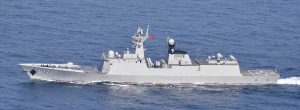Politics often drives a shift in naval fleet operations. As the late naval strategist Captain Wayne Hughes wrote: “Variables at the operational level of war stem not from technology but from social and political change.”
China’s Eastern Theater Navy (ETN) patrols in the southern East China Sea and around Taiwan likely follow this logic. The establishment of these patrols over the past several years likely seeks to change the status with its sea control force and enforce China’s claims.
The ETN maintains eight daily combatants patrolling near Japan and Taiwan (three and five, respectively). These patrols require 14 percent of the ETN’s corvettes, frigates, and destroyers to be underway each day. These force requirements possibly explain the People’s Liberation Army Navy’s decision to homeport six of the ten Type 054A (JiangkaI II) frigates in the latest production batch in the ETN.
The East China Sea patrols are reportedly near China’s claimed Air Defense Identification Zone (ADIZ), and the ETN supposedly commenced the patrol after the ADIZ establishment in November 2013. Additionally, some in the government of Japan believe the patrols are also linked to Beijing’s claims over disputed islands, given the proximity. The islands, known as the Senkaku in Japan and the Diaoyu in China, are under Japan’s administration but claimed also by China.
Close coordination between PLAN and the China Coast Guard (CCG) also makes these patrols problematic for Japan, given its laws (even with recent changes in authorities). Matching ETN patrols requires the Japan Maritime Self-Defense Force (JMSDF) to dedicate 7 percent of its frigates and destroyers to this mission. Maintaining a force that meets such operational demand is part of why the JMSDF is modernizing its escort force.
Similarly, the Taiwan patrols probably seek to reinforce China’s claims to sovereignty over Taiwan. Additionally, the patrols are likely meant to demonstrate capability and force Taipei to expend finite naval resources (at sea-days and operational tempo) in response. Beijing also likely utilizes increased PLAN activity during exercises to send political messages and deter other countries’ engagement with Taiwan.
The ETN has maintained an average presence of five combatant vessels around Taiwan since Taipei began releasing daily reports on such activity on August 5, 2022. A one-for-one shadow would require Taipei to keep 19 percent of the Republic of China Navy (ROCN) frigates and destroyers underway. Like the JMSDF, the ROCN is attempting to modernize its force with the Kang Ding frigate class upgrade and a new-generation light frigate program.
ETN patrols will undoubtedly continue and possibly increase. The ETN is set to receive at least four Type 055 (Renhai) cruisers over the next several years. The addition will give the ETN the flexibility to increase patrols or establish new missions. Either option reinforces Beijing’s claims while increasing the pressure on Taipei and Tokyo, likely turning China’s presence from a variable to a constant.

































